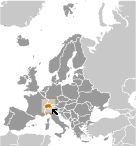World Atlas: Switzerland. On this page you can see the map, country flag and many detailed information about the people, history and economy of Switzerland.

Here you can find online selected information about the geography, inhabitants, government, economy and history of Switzerland. Included are selected statistics, an overview map and the detailed map of Switzerland. But let's start with the flag of Switzerland here:
Switzerland - Overview:
What you should know about Switzerland? Let's start with this: The Swiss Confederation was founded in 1291 as a defensive alliance among three cantons. In succeeding years, other localities joined the original three. The Swiss Confederation secured its independence from the Holy Roman Empire in 1499. A constitution of 1848, subsequently modified in 1874, replaced the confederation with a centralized federal government. Switzerland's sovereignty and neutrality have long been honored by the major European powers, and the country was not involved in either of the two world wars. The political and economic integration of Europe over the past half century, as well as Switzerland's role in many UN and international organizations, has strengthened Switzerland's ties with its neighbors. However, the country did not officially become a UN member until 2002. Switzerland remains active in many UN and international organizations but retains a strong commitment to neutrality.
Geography of Switzerland
 Where on the globe is Switzerland? The location of this country is Central Europe, east of France, north of Italy. Total area of Switzerland is 41,277 sq km, of which 39,997 sq km is land. So this is not a large country. How could we describe the terrain of the country? This way: mostly mountains (Alps in south, Jura in northwest) with a central plateau of rolling hills, plains, and large lakes. The lowest point of Switzerland is Lake Maggiore 195 m, the highest point Dufourspitze 4,634 m. And the climate is temperate, but varies with altitude; cold, cloudy, rainy/snowy winters; cool to warm, cloudy, humid summers with occasional showers.
Where on the globe is Switzerland? The location of this country is Central Europe, east of France, north of Italy. Total area of Switzerland is 41,277 sq km, of which 39,997 sq km is land. So this is not a large country. How could we describe the terrain of the country? This way: mostly mountains (Alps in south, Jura in northwest) with a central plateau of rolling hills, plains, and large lakes. The lowest point of Switzerland is Lake Maggiore 195 m, the highest point Dufourspitze 4,634 m. And the climate is temperate, but varies with altitude; cold, cloudy, rainy/snowy winters; cool to warm, cloudy, humid summers with occasional showers.
Inhabitants of Switzerland
Let's take a look how many people live in Switzerland. The number is: 8,236,303 (July 2017 est.). So this is not very populous country. Who lives here? German 65%, French 18%, Italian 10%, Romansch 1%, other 6%. What are the languages in Switzerland? German (or Swiss German) (official) 63%, French (official) 22.7%, Italian (official) 8.1%, English 4.9%, Portuguese 3.7%, Albanian 3%, Serbo-Croatian 2.4%, Spanish 2.2%, Romansch (official) 0.5%, other 7.1%. And the religions: Roman Catholic 37.3%, Protestant 24.9%, other Christian 5.8%, Muslim 5.1%, other 1.4%, Jewish 0.2%, none 23.9%, unspecified 1.3% (2015 est.). How old are the people in average? 42.4 years. We have to add that this number is the median - so one half of the people is older than this, one half is younger. And what is their life expectancy (at birth)? This: 82.6 years. Where the people live in Switzerland? Here: population distribution corresponds to elevation with the northern and western areas far more heavily populated; the higher Alps of the south limit settlement. The major urban areas of Switzerland are: Zurich 1.246 million; BERN (capital) 358,000 (2015).
Government and Economy of Switzerland
The capital of Switzerland is Bern and the government type federal republic (formally a confederation). Let's take a look at the administrative divisions - 26 cantons (cantons, singular - canton in French; cantoni, singular - cantone in Italian; Kantone, singular - Kanton in German); Aargau, Appenzell Ausserrhoden, Appenzell Innerrhoden, Basel-Landschaft, Basel-Stadt, Berne/Bern, Fribourg/Freiburg, Geneve, Glarus, Graubuenden/Grigioni/Grischun, Jura, Luzern, Neuchatel, Nidwalden, Obwalden, Sankt Gallen, Schaffhausen, Schwyz, Solothurn, Thurgau, Ticino, Uri, Valais/Wallis, Vaud, Zug, Zuerich. Regarding the economy of Switzerland, important industrial products are machinery, chemicals, watches, textiles, precision instruments, tourism, banking, insurance, pharmaceuticals. Important agricultural products are grains, fruits, vegetables; meat, eggs, dairy products. The most important export commodities are machinery, chemicals, metals, watches, agricultural products and the most important export partners are Germany 14.4%, US 12.1%, UK 10.7%, China 9%, Hong Kong 6.1%, France 5.8%, Italy 4.9%, India 4.8% (2016). The most important import commodities are machinery, chemicals, vehicles, metals; agricultural products, textiles and the most important import partners are Germany 19.4%, US 9%, Italy 7.4%, UK 7.1%, UAE 6.2%, France 6.1%, China 4.7% (2016). How rich is Switzerland and how rich are people in this country? The most important number here is GDP per capita (PPP): $61,400 (2017 est.). This means the people are rich on average here. Let's add that this means Gross Domestic Product per person, which is recalculated with respect to the relative cost of local goods and services. And one more important number - population below poverty line: 6.6% (2014 est.).